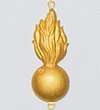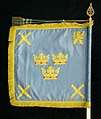Göta Artillery Regiment
The Göta Artillery Regiment (Swedish: Göta artilleriregemente), designation A 2, was a Swedish Army artillery regiment that traced its origins back to the 17th century. It was disbanded in 1962. The regiment's soldiers were originally recruited from Götaland, and it was also garrisoned there.
| Göta Artillery Regiment | |
|---|---|
| Göta artilleriregemente | |
| Active | 1794–1962 |
| Country | |
| Allegiance | Swedish Armed Forces |
| Branch | Swedish Army |
| Type | Artillery |
| Size | Regiment |
| Part of | 3rd Military Area (1833–1893) 3rd Army Division (1893–1901) III Army Division (1902–1927) Western Army Division (1928–1936) III Army Division (1937–1942) III Military Area (1942–1962) |
| Garrison/HQ | Gothenburg |
| Patron | Saint Barbara |
| Colors | Yellow |
| March | "Auf nach Valencia" (Eisengräber)[note 1] |
| Anniversaries | 4 December[note 2] |
| Insignia | |
| Branch insignia |  |
History
The regiment has its origins in the Artillery Regiment raised in 1636. That regiment was split into four new regiments in 1794 of which Göta Artillery Regiment was one. The regiment was given the designation A 2 (2nd Artillery Regiment) in 1830. In 1893 four companies were split off to form Norrland Artillery Regiment and Karlsborg Artillery Corps.
The regiment also changed name to 1st Göta Artillery Regiment (Första Göta artilleriregemente) in 1893, and another two companies were split off to form Småland Artillery Regiment in 1895. The name was changed back again in 1904. The regiment was garrisoned in Gothenburg until it was disbanded in 1962.
Campaigns
- ?
Organisation
- ?
Heraldry and traditions
The regiment was awarded a unit standard by His Majesty the Gustaf V on his birthday on 16 June 1938. During the disbandment of the regiment, Gothenburg Anti-Aircraft Corps took over traditions and the standard. Also part of the name was taken over by the anti-aircraft corps, when it on 1 July 1962 changed its name to Göta Anti-Aircraft Regiment (Göta luftvärnsregemente).[2] The memory of the regiment is carried on by the Artillery Regiment.[3]
 The regimental standard
The regimental standard The regimental standard
The regimental standard
Commanding officers
Regimental commanders between 1794 and 1962.[4]
- 1794–1801: Anders Leonard Treffenberg
- 1801–1817: Carl Ulric Silfversköld
- 1817–1834: Gillis Edenhjelm
- 1834–1840: Gustaf Adolf Flemming
- 1840–1849: Peter Carl Heijl
- 1849–1858: Bror Gustaf Reinhold Munck af Fulkila
- 1858–1860: Knut August Schytzerkrans
- 1860–1870: Charles Nicolas Berg
- 1870–1884: Frans Reinhold Carlsohn
- 1884–1888: Karl Vilhelm Kuylenstjerna
- 1888–1898: John Raoul Hamilton
- 1898–1904: Georg Liljenroth
- 1904–1913: Axel Bergenzaun
- 1913–1922: Carl Bastiat Hamilton
- 1922–1930: Sixten Schmidt
- 1930-1931: Oscar Osterman
- 1931–1936: Gunnar Salander
- 1936–1938: Axel Rappe
- 1938–1943: Sune Bergelin
- 1943–1946: Gunnar Ekeroth
- 1946–1957: Stig Tarras-Wahlberg
- 1957–1960: Alarik Astrup G:son Bergman
- 1960–1962: Nils Gustaf Holmstedt
Names, designations and locations
| Name | Translation | From | To | |
|---|---|---|---|---|
| Kungl. Göta artilleriregemente | Royal Göta Artillery Regiment | 1794-06-23 | – | 1892-12-31 |
| Kungl. Första Göta artilleriregemente | Royal First Göta Artillery Regiment | 1893-01-01 | – | 1904-12-07 |
| Kungl Göta artilleriregemente | Royal Göta Artillery Regiment | 1904-12-08 | – | 1962-03-31 |
| Avvecklingsorganisation | Decommissioning Organization | 1962-04-01 | – | 1962-09-30 |
| Designation | From | To | ||
| № 2 | 1816-10-01 | – | 1914-09-30 | |
| A 2 | 1914-10-01 | – | 1962-03-31 | |
| Location | From | To | ||
| Gothenburg/Otterhällan | 1806-03-31 | – | 1895-09-30 | |
| Gothenburg/Kviberg | 1895-10-01 | – | 1962-03-31 |
See also
Footnotes
- The march was established in 1953 by Army Order 33/1953. It was later used by the Östgota Army Air Battalion (Östgöta arméflygbataljon) from 1987 to 2004, and by the Gothenburg Group (Göteborgsgruppen) from 2000 to 2004.[1]
- 4 December is saint day of Saint Barbara.
References
Notes
- Sandberg 2007, p. 27
- Holmberg 1993, p. 34
- Försvarets traditioner 2015, p. 21
- Kjellander 2003, pp. 265-266
Print
- Holmberg, Björn (1993). Arméns regementen, skolor och staber: [en uppslagsbok] : en sammanställning (in Swedish). Arvidsjaur: Svenskt militärhistoriskt bibliotek (SMB). ISBN 91-972209-0-6. SELIBR 7796532.CS1 maint: ref=harv (link)
- Kjellander, Rune (2003). Sveriges regementschefer 1700-2000: chefsbiografier och förbandsöversikter (in Swedish). Stockholm: Probus. ISBN 91-87184-74-5. SELIBR 8981272.CS1 maint: ref=harv (link)
- Sandberg, Bo (2007). Försvarets marscher och signaler förr och nu: marscher antagna av svenska militära förband, skolor och staber samt igenkännings-, tjänstgörings- och exercissignaler (in Swedish) (New ed.). Stockholm: Militärmusiksamfundet med Svenskt marscharkiv. ISBN 978-91-631-8699-8. SELIBR 10413065.CS1 maint: ref=harv (link)
- Försvarets traditioner i framtiden med översiktlig historik från 1500-talet (PDF) (in Swedish). Statens försvarshistoriska museer TradN. 2015. ISBN 9789197859554. SELIBR 17552963.
Further reading
| Wikimedia Commons has media related to Göta Artillery Regiment. |
- Fredberg, Carl Rudolf A:son (1921–1922). Det gamla Göteborg: lokalhistoriska skildringar, personalia och kulturdrag. D. 2 (in Swedish). Gothenburg. pp. 225–249. SELIBR 2054907.CS1 maint: date format (link)
- Mankell, Julius (1866). Anteckningar rörande svenska regementernas historia (in Swedish) (2nd ed.). Örebro: Lindh. pp. 146–166. SELIBR 1549756.
- Modigh, Gunnar (1962). Kungl. Göta artilleriregemente: en minnesskrift 1644- 1794-1962 (in Swedish). Gothenburg: Skoogs bokförlag. SELIBR 2254863.
- Kungl. Göta artilleriregemente. 1 (in Swedish). Gothenburg: Regementets historiekommitté. 1954. SELIBR 8216108.
- Kungl. Göta artilleriregemente. 2, Regementets personhistoria 1794-1962 ; Det motoriserade regementet 1951-1962 (in Swedish). Gothenburg: Regementets historiekommitté. 1962. SELIBR 8216109.